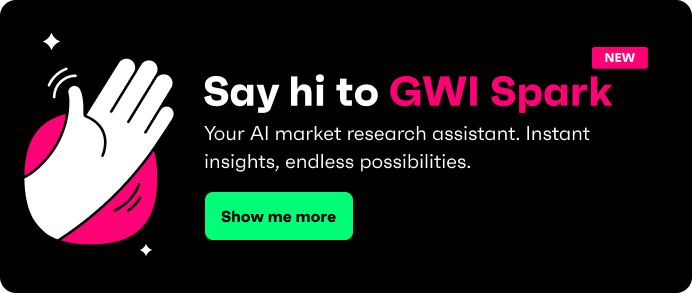
Let’s get straight into it: a customer insights strategy is your secret weapon for making smarter business moves. It’s the difference between launching a new feature based on gut feel, versus knowing your Gen-Z users have stopped using a tool because it’s not mobile-friendly.
Where analytics show what happened, consumer insights reveal why it matters and what you should do next. What motivates people to act? What needs are going unmet? Get this right and you’ll move faster, communicate better, and get ahead.
Audience dynamics are shifting quickly, especially now with Gen Z stepping into decision-making roles and changing the landscape. The 25 year-old marketing manager at a startup making decisions about CRM software is likely to have differing opinions to the Gen X execs that came before them.
If your insights don’t keep pace, you’ll miss the moment. But when they do? You gain the clarity to meet people where they are - not where you assumed they’d be. Let’s dive in and explore how to get it right, with some real-world examples to learn from.
Customer insights vs. consumer insights: what’s the difference and why it matters
They’re similar by name, but understanding the difference between customer and consumer insights is super important in building a strategy that works across your full funnel.
Customer insights focus on people you already know. Current users, buyers, or subscribers, for instance. The goal is to understand their post-purchase behaviors. Why do they stay? Why do they leave? What do they need more of?
Consumer insights, on the other hand, look at the broader market. These are the people you haven’t reached yet. You’re exploring general behaviors, motivations, and trends.
As an example, when Spotify wanted to expand in Southeast Asia, they didn’t just analyze current users, they also tapped into broader consumer sentiment around mobile data affordability, offline listening, and local music preferences. That consumer insight helped them localize features like downloadable playlists and regional language support.
So, the real magic happens when you blend the two. Use consumer insight to sharpen your acquisition game, then lean on customer insight to boost retention and satisfaction. Using this data together, you avoid assumptions, build richer audience profiles, and show up meaningfully at every stage.
The key pillars of a strong customer insights strategy
So how do you actually build a strategy that delivers? Read on! We’re sharing the five pillars that lay the foundation for something smart, scalable, and seriously effective.
Define strategic objectives
Start by getting clear on your goals. Are you trying to break into a new market? Improve retention? Launch smarter campaigns? The best insight strategies don’t sit in a vacuum. They’re tightly tied to business outcomes, so the insights you collect are directly relevant to the decisions you need to make.
Identify the right data sources
First-party data is a great start, but it’s not the whole picture. To really understand your audience, you need to pair what you know with broader context, like third-party survey data or market trends. Internal data often misses the emotional or attitudinal layer. A customer clicked. Sure. But why?
Having a tool like GWI Spark on-hand gives you this view. It’ll connect you with insights from real, global consumers, not just the ones already in your CRM.
Smarter segmentation through insight-led personas
When your favorite streamer recommends your guilty pleasure when you boot it up, that’s no accident. Real insight-led segmentation like that looks at values, motivations, mindset, and behaviors - taking you from generic “millennial marketer” to someone who cares about sustainability, prioritizes work-life balance, and prefers learning from short-form video - the full picture.
Take Gen-Z. This is a group that values transparency and activism from the brands they choose, and is also (whether they like it or not) deeply shaped by digital culture - they’re more responsive to a brand hopping on a trending meme. Brands like Duolingo have leaned into this by creating TikTok personas that are funny, self-aware, and intentionally low-fi. The result? Duolingo has over 10 million TikTok followers. Nice. (See what we did there?)
So - the impact of smart segmentation? Sharper creative, stronger personalization, and campaigns that actually resonate. And beyond marketing, it helps product teams tailor features, and CX teams refine onboarding based on audience mindset.
Choose the right tools and platforms
Your data is only as good as the tools behind it. You’ll want to look for platforms that offer speed, reliability, and credibility, and can scale as your needs grow.
GWI Spark is a prime example. It taps into trusted, survey-based data from nearly a million consumers worldwide, giving you access to granular, real-time insights across over 50 markets. Whether you're tweaking a pitch or planning a campaign, you’ll have the right data at your fingertips, fast.
Build cross-functional insight loops
Insights don’t just belong to marketing. When shared across product, CX, and HR, they become a company-wide superpower. It’s not about dumping data into everyone’s lap, but creating a loop where one team’s insight becomes another’s springboard.
Marketing shares audience findings with product, which adapts features based on motivations. HR uses those same insights to shape internal culture, messaging, and support systems.
Take workplace wellbeing, for instance. Since 2020, there’s been a 25% rise in Gen Z reporting a mental health condition. And those who receive support at work? They’re 19% more likely to be happy in their roles. A spike in support tickets around burnout could be shared with HR, who then roll-out mental health days and Slack-free Fridays - that’s real insight in action, critical for shaping benefits, retention, and leadership priorities.
Common pitfalls in customer insights strategy and how to avoid them
Even the best strategies can fall flat if you’re not careful. Some common traps:
- Relying too much on internal data. You’ll end up with a narrow view and potentially outdated assumptions.
- Oversimplifying audience motivations. People are complex! Treat them that way.
- Letting insights live in silos. When teams don’t share, opportunities get missed.
- Failing to refresh your personas. Behaviors change, so your strategy should too.
GWI Spark helps sidestep these issues by offering one central place to access real-time, audience-level data. No silos, no guesswork.
How GWI Spark enhances your customer insights strategy
GWI Spark makes insights easier to access and act on. It’s your AI assistant for audience discovery, built on data you can trust.
Using robust, survey-based data from real people across the globe, you can analyze and compare audiences across geos and demographics, track behavior shifts over time, and surface fresh insights in seconds.
One quick example? We uncovered that Gen Z TikTokers are now using the platform for messaging more than ever, up 82% since 2020. Insights like this help brands rethink platform strategies and content formats without wasting time or budget.
With GWI Spark, you don’t need to be a data expert. You just need a question.
Measuring the impact of your insights strategy
A good insights strategy should lead to better results. But how do you measure that?
Start with core metrics like customer retention, lifetime value, and NPS. Then look at campaign performance. Are segments converting better? Are messages landing?
With GWI Spark, benchmarking becomes easy. You can track how audience preferences shift over time, test new messaging before rollout, and validate regional strategies as you go.
Real-world impact: how better insights drive smarter decisions
When insights are embedded in your workflow, everything improves.
Segmentation gets sharper and your personalization lands better. Messaging becomes more timely and relevant, because you’re reacting to real behavior, not last quarter’s assumptions. Teams move faster, confident in the data. Everything just works better.
With GWI Spark, this becomes second nature. Whether you’re updating the tone for Gen Z’s communication style, adjusting product positioning by market, or exploring expansion opportunities, you’ll have the approach you need to move forward with certainty.
Final thoughts: elevating customer strategy with consumer insight
The smartest customer strategies are built on a deep understanding of the real people behind the data. When you blend customer and consumer insight, you’re not reacting to trends, but anticipating them.
That’s why we’re seeing more world-leading teams turn to GWI Spark. They’re able to spot shifting needs early and craft strategies that keep up with fast-changing audiences.
Want to see what smarter insights could look like for your team? Start exploring GWI Spark and build an insights strategy that actually works.





.webp?width=495&height=317&name=pink_thumb_graphs%20(1).webp)
.webp?width=495&height=317&name=pink_thumb_letter%20(2).webp)